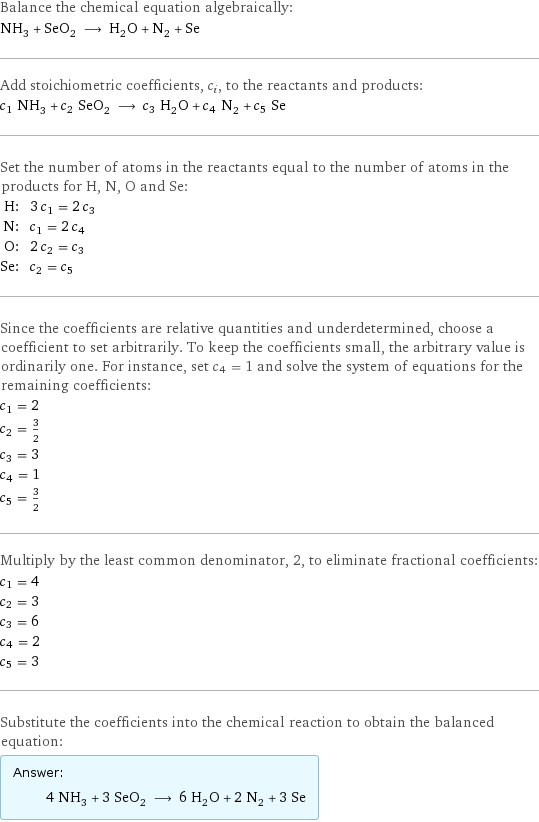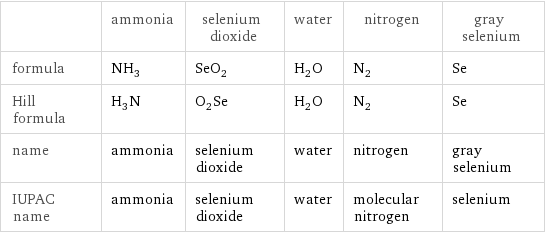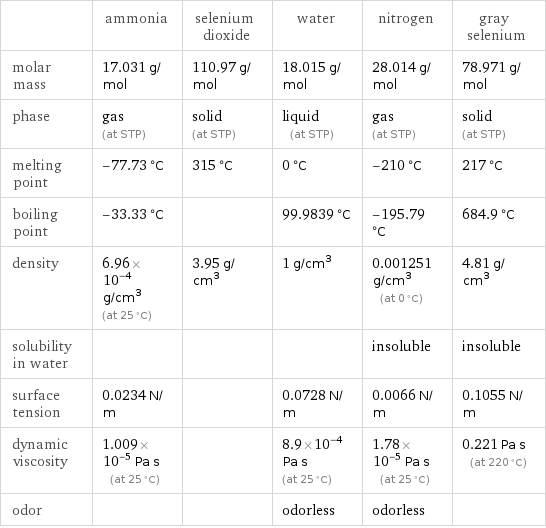Input interpretation

NH_3 ammonia + SeO_2 selenium dioxide ⟶ H_2O water + N_2 nitrogen + Se gray selenium
Balanced equation

Balance the chemical equation algebraically: NH_3 + SeO_2 ⟶ H_2O + N_2 + Se Add stoichiometric coefficients, c_i, to the reactants and products: c_1 NH_3 + c_2 SeO_2 ⟶ c_3 H_2O + c_4 N_2 + c_5 Se Set the number of atoms in the reactants equal to the number of atoms in the products for H, N, O and Se: H: | 3 c_1 = 2 c_3 N: | c_1 = 2 c_4 O: | 2 c_2 = c_3 Se: | c_2 = c_5 Since the coefficients are relative quantities and underdetermined, choose a coefficient to set arbitrarily. To keep the coefficients small, the arbitrary value is ordinarily one. For instance, set c_4 = 1 and solve the system of equations for the remaining coefficients: c_1 = 2 c_2 = 3/2 c_3 = 3 c_4 = 1 c_5 = 3/2 Multiply by the least common denominator, 2, to eliminate fractional coefficients: c_1 = 4 c_2 = 3 c_3 = 6 c_4 = 2 c_5 = 3 Substitute the coefficients into the chemical reaction to obtain the balanced equation: Answer: | | 4 NH_3 + 3 SeO_2 ⟶ 6 H_2O + 2 N_2 + 3 Se
Structures

+ ⟶ + +
Names

ammonia + selenium dioxide ⟶ water + nitrogen + gray selenium
Equilibrium constant
![Construct the equilibrium constant, K, expression for: NH_3 + SeO_2 ⟶ H_2O + N_2 + Se Plan: • Balance the chemical equation. • Determine the stoichiometric numbers. • Assemble the activity expression for each chemical species. • Use the activity expressions to build the equilibrium constant expression. Write the balanced chemical equation: 4 NH_3 + 3 SeO_2 ⟶ 6 H_2O + 2 N_2 + 3 Se Assign stoichiometric numbers, ν_i, using the stoichiometric coefficients, c_i, from the balanced chemical equation in the following manner: ν_i = -c_i for reactants and ν_i = c_i for products: chemical species | c_i | ν_i NH_3 | 4 | -4 SeO_2 | 3 | -3 H_2O | 6 | 6 N_2 | 2 | 2 Se | 3 | 3 Assemble the activity expressions accounting for the state of matter and ν_i: chemical species | c_i | ν_i | activity expression NH_3 | 4 | -4 | ([NH3])^(-4) SeO_2 | 3 | -3 | ([SeO2])^(-3) H_2O | 6 | 6 | ([H2O])^6 N_2 | 2 | 2 | ([N2])^2 Se | 3 | 3 | ([Se])^3 The equilibrium constant symbol in the concentration basis is: K_c Mulitply the activity expressions to arrive at the K_c expression: Answer: | | K_c = ([NH3])^(-4) ([SeO2])^(-3) ([H2O])^6 ([N2])^2 ([Se])^3 = (([H2O])^6 ([N2])^2 ([Se])^3)/(([NH3])^4 ([SeO2])^3)](../image_source/20739e898936a9f81f4a22b8d986ce01.png)
Construct the equilibrium constant, K, expression for: NH_3 + SeO_2 ⟶ H_2O + N_2 + Se Plan: • Balance the chemical equation. • Determine the stoichiometric numbers. • Assemble the activity expression for each chemical species. • Use the activity expressions to build the equilibrium constant expression. Write the balanced chemical equation: 4 NH_3 + 3 SeO_2 ⟶ 6 H_2O + 2 N_2 + 3 Se Assign stoichiometric numbers, ν_i, using the stoichiometric coefficients, c_i, from the balanced chemical equation in the following manner: ν_i = -c_i for reactants and ν_i = c_i for products: chemical species | c_i | ν_i NH_3 | 4 | -4 SeO_2 | 3 | -3 H_2O | 6 | 6 N_2 | 2 | 2 Se | 3 | 3 Assemble the activity expressions accounting for the state of matter and ν_i: chemical species | c_i | ν_i | activity expression NH_3 | 4 | -4 | ([NH3])^(-4) SeO_2 | 3 | -3 | ([SeO2])^(-3) H_2O | 6 | 6 | ([H2O])^6 N_2 | 2 | 2 | ([N2])^2 Se | 3 | 3 | ([Se])^3 The equilibrium constant symbol in the concentration basis is: K_c Mulitply the activity expressions to arrive at the K_c expression: Answer: | | K_c = ([NH3])^(-4) ([SeO2])^(-3) ([H2O])^6 ([N2])^2 ([Se])^3 = (([H2O])^6 ([N2])^2 ([Se])^3)/(([NH3])^4 ([SeO2])^3)
Rate of reaction
![Construct the rate of reaction expression for: NH_3 + SeO_2 ⟶ H_2O + N_2 + Se Plan: • Balance the chemical equation. • Determine the stoichiometric numbers. • Assemble the rate term for each chemical species. • Write the rate of reaction expression. Write the balanced chemical equation: 4 NH_3 + 3 SeO_2 ⟶ 6 H_2O + 2 N_2 + 3 Se Assign stoichiometric numbers, ν_i, using the stoichiometric coefficients, c_i, from the balanced chemical equation in the following manner: ν_i = -c_i for reactants and ν_i = c_i for products: chemical species | c_i | ν_i NH_3 | 4 | -4 SeO_2 | 3 | -3 H_2O | 6 | 6 N_2 | 2 | 2 Se | 3 | 3 The rate term for each chemical species, B_i, is 1/ν_i(Δ[B_i])/(Δt) where [B_i] is the amount concentration and t is time: chemical species | c_i | ν_i | rate term NH_3 | 4 | -4 | -1/4 (Δ[NH3])/(Δt) SeO_2 | 3 | -3 | -1/3 (Δ[SeO2])/(Δt) H_2O | 6 | 6 | 1/6 (Δ[H2O])/(Δt) N_2 | 2 | 2 | 1/2 (Δ[N2])/(Δt) Se | 3 | 3 | 1/3 (Δ[Se])/(Δt) (for infinitesimal rate of change, replace Δ with d) Set the rate terms equal to each other to arrive at the rate expression: Answer: | | rate = -1/4 (Δ[NH3])/(Δt) = -1/3 (Δ[SeO2])/(Δt) = 1/6 (Δ[H2O])/(Δt) = 1/2 (Δ[N2])/(Δt) = 1/3 (Δ[Se])/(Δt) (assuming constant volume and no accumulation of intermediates or side products)](../image_source/c87c6d6fabc46003ed963583d060d6ec.png)
Construct the rate of reaction expression for: NH_3 + SeO_2 ⟶ H_2O + N_2 + Se Plan: • Balance the chemical equation. • Determine the stoichiometric numbers. • Assemble the rate term for each chemical species. • Write the rate of reaction expression. Write the balanced chemical equation: 4 NH_3 + 3 SeO_2 ⟶ 6 H_2O + 2 N_2 + 3 Se Assign stoichiometric numbers, ν_i, using the stoichiometric coefficients, c_i, from the balanced chemical equation in the following manner: ν_i = -c_i for reactants and ν_i = c_i for products: chemical species | c_i | ν_i NH_3 | 4 | -4 SeO_2 | 3 | -3 H_2O | 6 | 6 N_2 | 2 | 2 Se | 3 | 3 The rate term for each chemical species, B_i, is 1/ν_i(Δ[B_i])/(Δt) where [B_i] is the amount concentration and t is time: chemical species | c_i | ν_i | rate term NH_3 | 4 | -4 | -1/4 (Δ[NH3])/(Δt) SeO_2 | 3 | -3 | -1/3 (Δ[SeO2])/(Δt) H_2O | 6 | 6 | 1/6 (Δ[H2O])/(Δt) N_2 | 2 | 2 | 1/2 (Δ[N2])/(Δt) Se | 3 | 3 | 1/3 (Δ[Se])/(Δt) (for infinitesimal rate of change, replace Δ with d) Set the rate terms equal to each other to arrive at the rate expression: Answer: | | rate = -1/4 (Δ[NH3])/(Δt) = -1/3 (Δ[SeO2])/(Δt) = 1/6 (Δ[H2O])/(Δt) = 1/2 (Δ[N2])/(Δt) = 1/3 (Δ[Se])/(Δt) (assuming constant volume and no accumulation of intermediates or side products)
Chemical names and formulas

| ammonia | selenium dioxide | water | nitrogen | gray selenium formula | NH_3 | SeO_2 | H_2O | N_2 | Se Hill formula | H_3N | O_2Se | H_2O | N_2 | Se name | ammonia | selenium dioxide | water | nitrogen | gray selenium IUPAC name | ammonia | selenium dioxide | water | molecular nitrogen | selenium
Substance properties

| ammonia | selenium dioxide | water | nitrogen | gray selenium molar mass | 17.031 g/mol | 110.97 g/mol | 18.015 g/mol | 28.014 g/mol | 78.971 g/mol phase | gas (at STP) | solid (at STP) | liquid (at STP) | gas (at STP) | solid (at STP) melting point | -77.73 °C | 315 °C | 0 °C | -210 °C | 217 °C boiling point | -33.33 °C | | 99.9839 °C | -195.79 °C | 684.9 °C density | 6.96×10^-4 g/cm^3 (at 25 °C) | 3.95 g/cm^3 | 1 g/cm^3 | 0.001251 g/cm^3 (at 0 °C) | 4.81 g/cm^3 solubility in water | | | | insoluble | insoluble surface tension | 0.0234 N/m | | 0.0728 N/m | 0.0066 N/m | 0.1055 N/m dynamic viscosity | 1.009×10^-5 Pa s (at 25 °C) | | 8.9×10^-4 Pa s (at 25 °C) | 1.78×10^-5 Pa s (at 25 °C) | 0.221 Pa s (at 220 °C) odor | | | odorless | odorless |
Units
